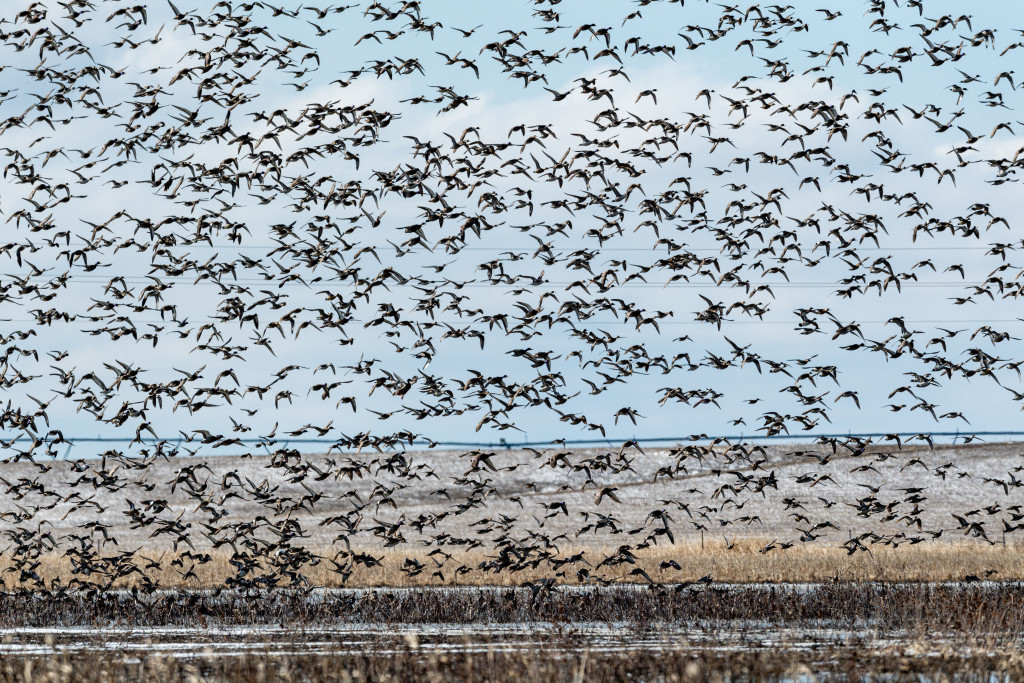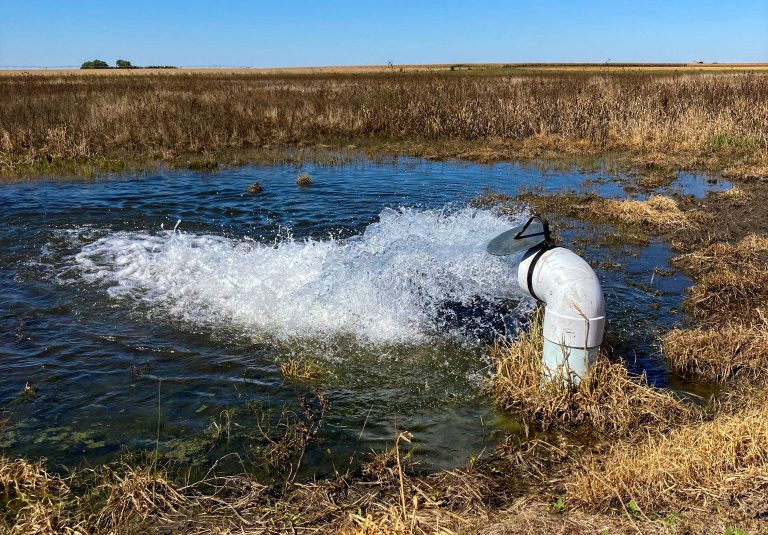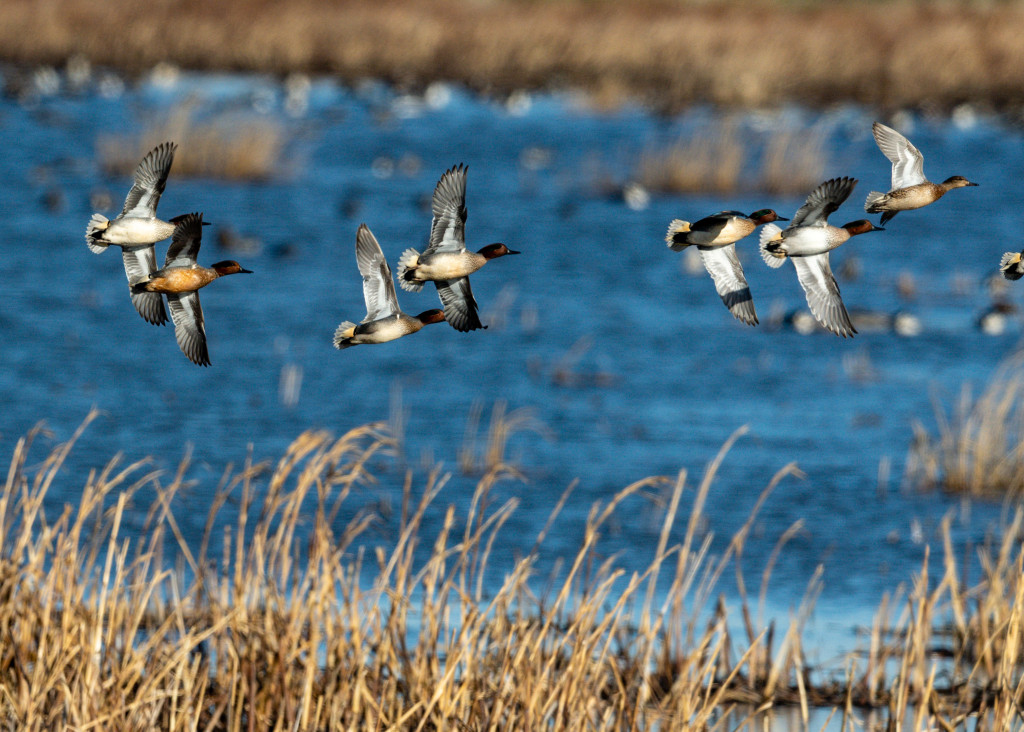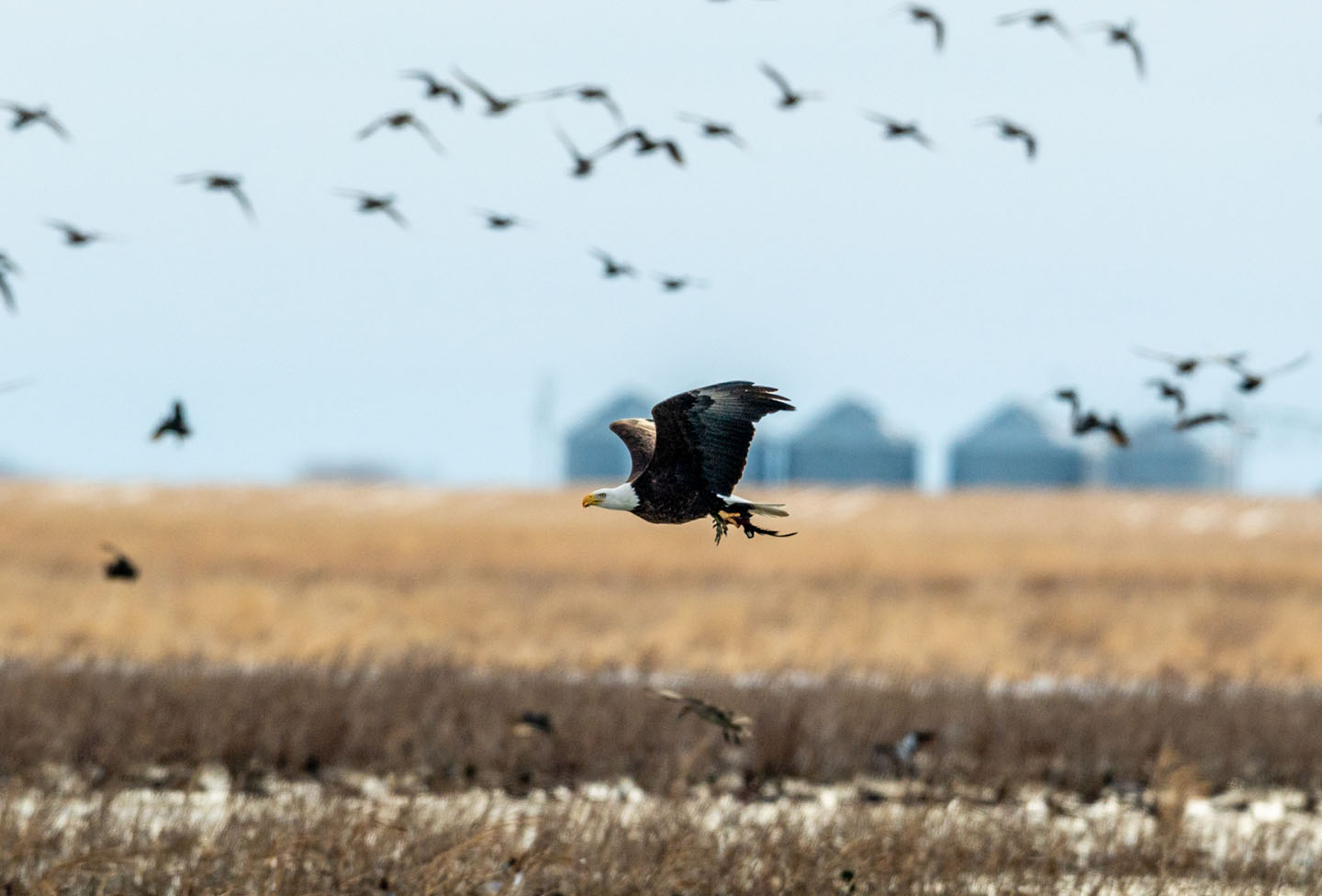
By Eric Fowler
Wetlands in the Rainwater Basin provide premier habitat for ducks, geese, shorebirds and other species during the spring migration. While in this part of south-central Nebraska, the birds fatten up for the rest of their journey to breeding grounds in the north, whether it be in the Sandhills or the prairie potholes of the Upper Midwest and Canada.
But that is only the case when the wetlands are wet. This spring, during severe drought, few would have held water had the Nebraska Game and Parks Commission and U.S. Fish and Wildlife Service not pumped them at select locations. Combined, both agencies pumped groundwater at 24 of the 94 wetlands they own and manage for wildlife, helping maintain the habitat that wasn’t lost to agriculture and development. Even fewer would have been wet if not for the first disbursement of cash from Ducks Unlimited’s new Rainwater Basin Water Development Fund.
The water development fund, established in 2019, is a partnership between DU, the Game and Parks Commission, USFWS and the Rainwater Basin Joint Venture. The goal is to create a $7 million interest-bearing account that would provide more than $300,000 annually to fund pumping, improvements to pumping infrastructure, and wetland restoration work. To date, $800,000 has been donated or pledged, and this spring, approximately $20,000 in interest was transferred to the agencies to use on their areas as well as on the Verona Complex, which is owned by DU’s land trust and open to the public.
And it worked.
“Every basin we pumped [this spring] had birds on it,” said Terry Kostinec, director of development for DU in Nebraska and South Dakota. “We even had whooping cranes sighted on a number of these sites.”

In wet years, a limited amount of money is spent on pumping, but in dry years, the Game and Parks Commission typically spends about $30,000 on its wildlife management areas, primarily in the fall to provide opportunities for hunters, said Ted LaGrange, wetland program manager with the Game and Parks Commission. Were it not for the funding provided by DU’s water fund, the Commission may have not pumped any of the 12 wetlands it did this past spring, LaGrange said.
The USFWS typically spends between $80,000 and $125,000 on pumping on its waterfowl production areas in the spring and fall, said Brad Krohn, project leader of the Rainwater Basin Management District. The additional funding from DU allowed them to run pumps powered by diesel longer than they would have on some areas, a growing concern amid high fuel prices.
Ducks, geese, shorebirds and other water birds stop in the Rainwater Basin during spring migration to feast on flooded seed sources, such as smartweed and barnyard grass, along with a smorgasbord of insects and other invertebrates. Research has shown the quality of spring migration habitat is key.
“If you can get the birds to the breeding grounds alive and healthy, they’re going to reproduce better, which is going to lead to a better fall flight,” said
LaGrange, noting the fund may allow the Game and Parks Commission to continue to pump more in the spring.
The USFWS also pumps water on some of its wetlands in the fall, beginning early enough on some to provide water during the early teal season in September, and continuing after the growing season to provide water during the regular duck season in October and November. Krohn said they may be able to do more fall pumping with the help of the water fund.
Fall pumping can help ensure conditions will be better in the spring, as it can take a substantial amount of water to fill the dry, cracked clay soils and seal the base of the wetlands. Combined with the frost layer that develops in moist soils when cold temperatures arrive, these marshes can more readily capture and hold runoff from melting snow or rain or pumped water longer than a bone-dry wetland come spring.
“Our No. 1 priority, the whole reason the district is here, is for supporting spring migration,” Krohn said. “But we pump a lot in the fall as well, focusing on public use and areas that we are planning to manage for our spring pumping.”

Pumping in the spring comes in stages. The USFWS pumps larger marshes first. These areas are attractive to the massive flocks of snow geese, some of the first migrants to arrive and first to leave in the spring. It then pumps shallower wetlands with abundant seed sources for the pintails, mallards, white-fronted geese and other waterfowl that arrive later. Krohn said snow geese can deplete these food sources if they are pumped too early. Later pumping also ensures favorable conditions for shorebirds that arrive in April and May.
“That’s the benefit of pumping later,” Krohn said. “We’re supporting the entire length of the migration instead of just one aspect of it.”
During the past 15 years, the Game and Parks Commission, with the assistance of DU and other conservation partners, has added or improved wells, pumps and power sources and installed underground pipelines to efficiently deliver water from wells on high ground to the wetlands below on 18 wildlife areas in the basins. It has also completed restoration projects on 22 areas, removing sediment and filling pits. And in some instances where the Game and Parks Commission owned only a portion of a wetland, it has purchased property from willing sellers to bring more of the wetland into public ownership, making it possible to pump more water without flooding a neighbor.
The USFWS has done the same during the past 10 years, drilling new wells on seven areas and replacing pumps on two, as well as adding pipelines and doing other restoration work. But Krohn said it has a big backlog of projects awaiting funding, including replacing or repairing 35 of its 63 wells that are inoperable.
Kostinec said DU’s goal is to help the Game and Parks Commission and the USFWS continue their efforts and restore another 23,000 acres of wetlands by making these types of improvements so more water can be available each spring.
“Mother Nature doesn’t consistently put moisture across the landscape,” he said. “And the pumping budgets for the state and federal agencies have just never kept up.
“If we can achieve a $7 million investment goal, the interest that spins off that every year would essentially take care of all pumping needs and alleviate the problem of agencies fighting for a budget to do a little bit of pumping here and there each year. And once fully funded, it has the capability of really upgrading the infrastructure and continuing to help pay for restoration efforts in the region.”
Proceeds from the Federal Duck Stamp, Nebraska Habitat Stamp and Nebraska Waterfowl Stamp, all required by waterfowl hunters, have been used to purchase land from willing sellers in the Rainwater Basin and restore wetlands since 1962. The Game and Parks Commission owns 35 wildlife management areas in the area, 29 with wells and pumps. The USFWS owns 59 waterfowl production areas, 25 of which have operational wells and two that can capture surface water from canals diverting water from the Platte River. The number of wells used to maintain these areas for wildlife represents .3 percent of the 31,000 registered wells in the Rainwater Basin region.

These 95 marshes and a few hundred more found on private land represent only 10 percent of 4,000 permanent and seasonal wetlands ranging from 40 to 1,000 acres in size that once dotted the region. The rest were drained or filled and are now farmed, most of them since World War II. Development altered the hydrology of many that remain, with roads, terraces and reuse pits keeping runoff from reaching some wetlands and erosion filling others with sediment.
Managing what remains, including pumping water when needed, is critical to ensure birds have what they need when they stop, said LaGrange. It also spreads out the birds, reducing the chances for disease outbreaks, such as avian cholera, that have claimed 100,000 birds in a single spring in years past.
“Hunters like large concentrations of birds, and for birdwatchers it’s an amazing spectacle to see tens of thousands or even a million birds on a given spot,” he said. “But if those birds get spread out, you’re going to minimize the probability of a large die-off. It’s social distancing for birds.”
LaGrange and Krohn said their agencies are grateful for DU’s effort and look forward to using the fund to do more for wildlife, hunters and birdwatchers. Judging from the hundreds of thousands of birds that stopped last spring, the birds are grateful, too.
To make a donation to the Rainwater Basin Water Development Fund, contact Terry D. Kostinec, director of development, South Dakota/Nebraska, at 605-760-5791 or tkostinec@ducks.org.
Pumping Basics
Pumping water into Rainwater Basin wetlands to provide habitat for migratory birds can be beneficial, but it is not always feasible.
Care needs to be taken so neighboring private lands are not affected, especially before the crops are harvested.
Wetlands in the area aren’t always wet. The wet/dry cycle is natural and promotes the growth of plants that provide seed sources for birds.
Wetlands with moist soils are usually the first to be pumped. When clay soils are dry and cracked, much of the pumped water flows into the ground and it can take a lot of water just to seal the soil before it can pool. Rainwater or pumped water flowing though the cracked soils helps recharge groundwater.
In the fall, most pumping begins after a killing frost, ensuring plants won’t suck up the water and when evaporation rates are lower.
Pumping occurs outside the irrigation season, and, in an average year, the amount pumped at all state and federal wetlands combined in spring and fall amounts to what is used to irrigate three sections of farmland.
In most cases, only enough water is pumped to flood vegetation that ducks and geese like to eat. It is not feasible to pump enough to float a duck boat.
